If you’re searching for information about “old basement drainage systems,” you probably live in an older home with a damp basement. If so, you’ve landed on the right page because that’s what we’re going to talk about in this article. We will go over why basements in older homes are often damp, the best way to dry out a basement in an older home using a particular type of drainage system, and more.
Why Are Basements In Older Homes Often Damp?
Water infiltration in older basements can happen for several reasons, both external and internal. These include the following:
Water is seeping through the foundation walls and floor
The number one reason basements in older homes get wet is groundwater seeping through the foundation walls and floor. This happens because older homes are less likely to have a proper drainage system installed around the foundation. We’ll talk more about the most effective drainage system for older homes in just a bit.
The lack of a proper drainage system and water accumulation in the ground around the foundation can cause hydrostatic pressure to build up and push against the foundation walls. (Your basement walls, in other words.) Hydrostatic pressure is strong enough to push water through invisible cracks in the wall and into your basement. If the pressure isn’t relieved, your basement walls could even bow inward and crack.
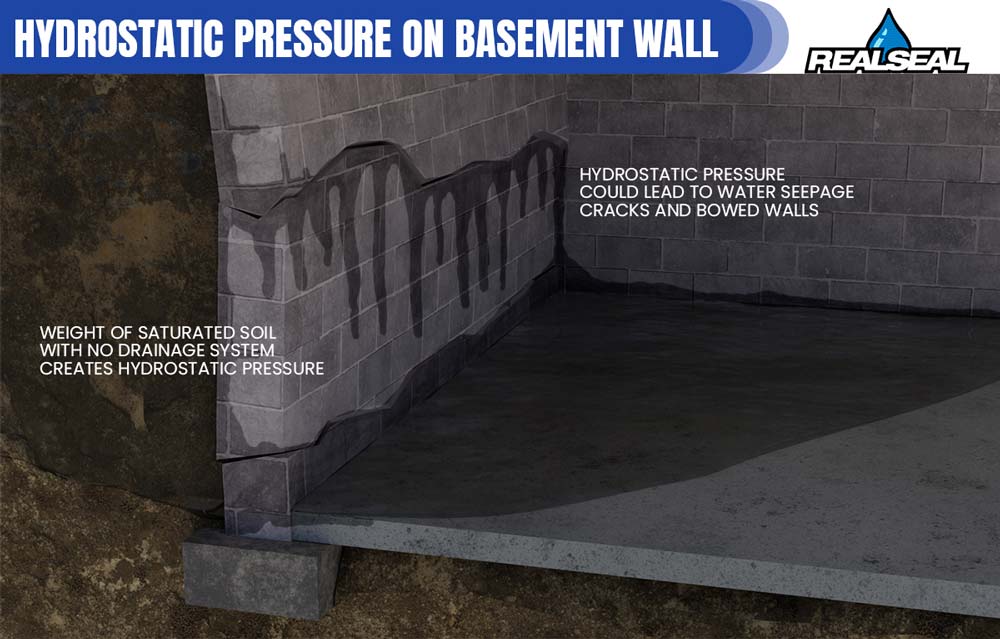
So, the question is, why is there so much water in the ground around the foundation? How did it get there? Here are a few reasons:
- There’s no drainage system present – As we just noted, the absence of a drainage system is one of the leading causes of moisture build-up in the ground around a foundation.
- There’s something wrong with the gutters – Gutters clogged with decaying leaves or other debris can cause water to spill over the side of the house and soak into the ground around the foundation. The gutters might also have holes in them (or some other type of damage), causing the same thing to happen. Either way, runoff is being deposited around the foundation. It soaks into the ground and eventually finds its way into the basement.
- The yard around the house isn’t correctly graded – If the yard slopes toward the house, groundwater will drain toward the foundation instead of away from it.
- There’s a plumbing leak somewhere – A water or sewer line crack can be another source of excess moisture in the soil around a foundation.
- The downspouts are too short – If your downspouts are too short, they’ll release water too close to the foundation.
- You’ve got water-hungry vegetation planted next to the house – Those flowers and shrubs might look nice, but when you water them, you add more moisture to the ground around the foundation. This is what you’re trying to avoid.
You’ve got leaky plumbing
Pipes that run through basements or underneath them can develop leaks, leading to seepage into the basement.
Condensation
Open basement windows can cause warm, humid air to flow into the basement and condense on cooler surfaces.
There’s an unvented clothes dryer, kitchen, or bathroom in the basement
All three of these can be a source of moisture in a basement.
Drain Tile: The Ultimate Basement Waterproofing System For Older Homes
Due to its effectiveness and long-lasting results, a drain tile system is a gold standard for basement waterproofing in older homes. Apart from a few minor maintenance tasks, it’s pretty much set it and forget it.
This foundation waterproofing method involves digging a trench along either the outside of the foundation wall at the footing level (exterior type) or along the inside perimeter of the basement (interior type). An interior drain tile system means using a jackhammer to break up an area of the basement floor to install the drainage pipe.
The general installation procedure for installing an exterior drain tile system is as follows:
- First, the soil around the foundation is excavated down to the footing.
- Next, a shallow trench is dug around the foundation’s perimeter and lined with gravel.
- A drainage pipe with small holes is placed into the trench on top of the gravel and covered with more gravel.
- Finally, the excavated soil is replaced.
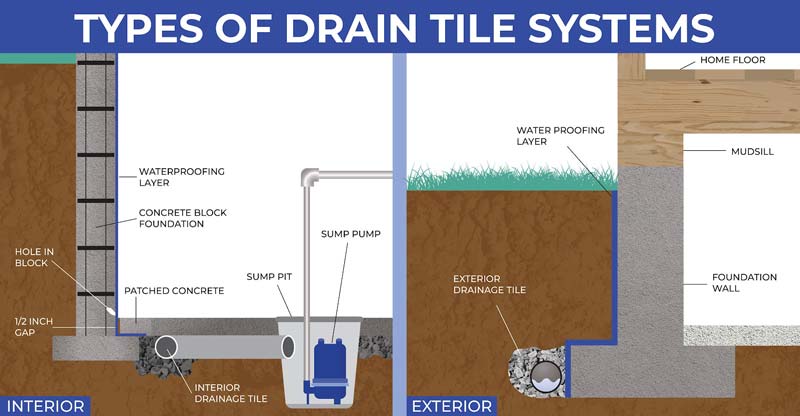
Excess moisture in the soil will now flow into the drainage pipe and towards a sump pit. When the pit fills with water, a sump pump will turn on and release the water a safe distance from the foundation.
The installation for an interior drain tile system is similar, except that it goes around the inside perimeter of the basement.
For more information, see How A Drain Tile System Can Save You Money.
Why A Drain Tile System Is The Best Basement Waterproofing System
Although a drain tile system will cost you some money to install, there are some reasons why it’s the best basement waterproofing solution:
- Prevents water from building up in the ground around the foundation. Instead of merely putting up a barrier to keep water out, a drain tile system intercepts excess groundwater and redirects it away from the foundation. In other words, a drain tile system prevents water build-up in the soil. This reduces hydrostatic pressure that could cause cracks or leaks in the basement walls.
- Works with other waterproofing methods – A drain tile system can complement other basement waterproofing methods, such as exterior waterproofing. This combination ensures that the basement remains dry regardless of any weather conditions.
- Long-lasting solution – Unlike other basement waterproofing methods requiring frequent maintenance or repairs, a drain tile system can last decades without much attention. The pipes used in this method are made from durable materials such as PVC or HDPE, and the gravel used in the trench doesn’t decompose or erode quickly.
- Improves indoor air quality – Some of the basement’s air flows into your home’s living area. Therefore, a damp, moldy basement could harm your indoor air quality and cause health problems for anyone living in the house. With a drain tile system in place, the basement remains dry, thus improving the overall indoor air quality.
- Cost-effective solution – While the initial cost of installing a drain tile system might be higher compared to other basement waterproofing methods, the long-term benefits make it a cost-effective solution. A drain tile system doesn’t need frequent maintenance, doesn’t require any electrical work, and could increase the property’s overall value.
Other Things You Can Do To Keep Your Basement Dry
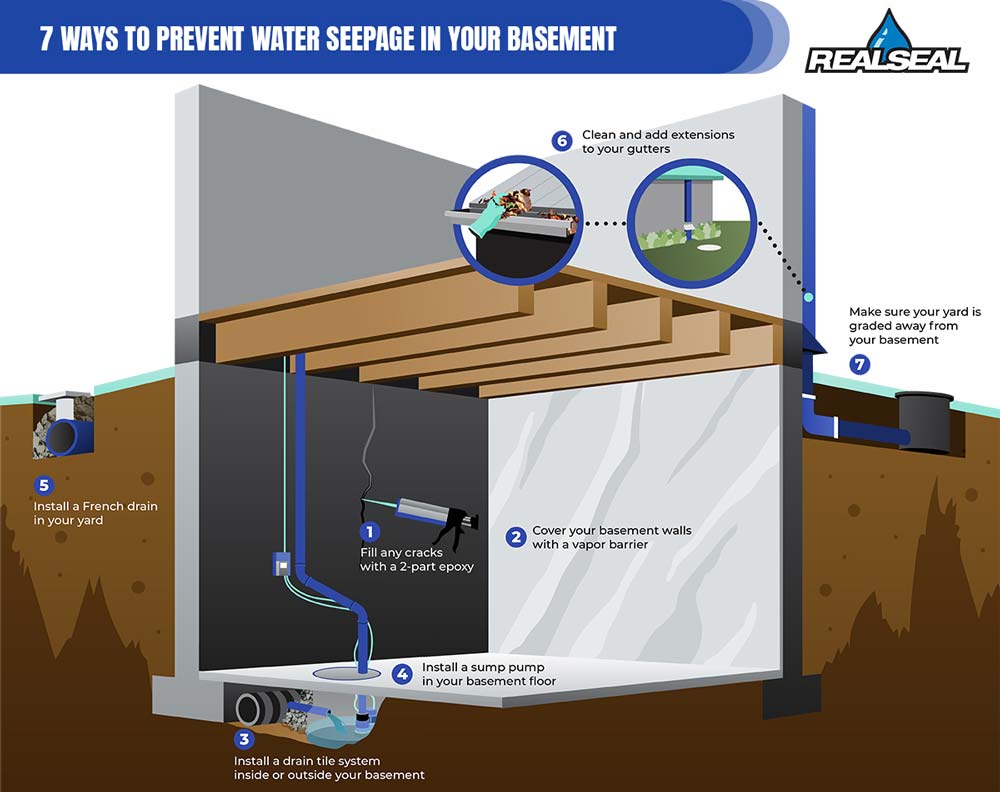
In addition to a drain tile system, homeowners can take several other measures to help keep their basement dry and free of moisture. These include the following:
- One of the most effective ways to keep a basement dry is by regrading the yard around the foundation so that it slopes away from the foundation. This way, rainwater and snowmelt will naturally flow away from the foundation, reducing the likelihood of water seeping into the basement. A professional landscaping company can help with this, or it could be a good DIY project.
- Another critical step to take is to clean gutters regularly. Clogged gutters can cause rainwater to overflow and spill over the side of the house, potentially finding its way into the basement. Therefore, homeowners should make sure to clear their gutters of debris at least twice a year.
- Using downspout extensions is another effective way to help keep a basement dry. Downspout extensions direct runoff away from the foundation and should be long enough to ensure the water gets released at least 15 feet from the foundation. This reduces the risk of water entering the basement.
- Homeowners should also avoid planting vegetation next to the foundation. Plants, especially those with deep roots, can cause the soil to shift and create openings for water to seep into the basement. Therefore, it’s recommended that shrubs, bushes, and other foliage be planted at least several feet away from the foundation.
If you’re considering a basement drainage system for your older Chicagoland home, contact The Real Seal today to schedule an evaluation.
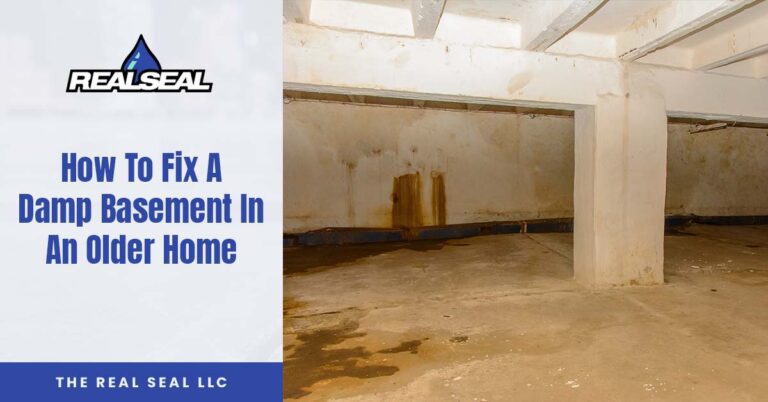
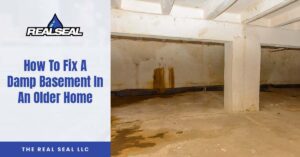





4 Responses
Great tips! I’ve been struggling with a damp basement in my older home for years. I especially appreciate the advice on proper ventilation and adding a dehumidifier. Can’t wait to try these solutions!
Hope you get some use out of it!
Great tips in this post! I’ve been dealing with a damp basement in my older home for years, and the suggestions on proper drainage and ventilation methods are really helpful. I hadn’t thought about checking the gutters and downspouts more closely. Looking forward to trying some of these solutions!
Looking forward to seeing your results!